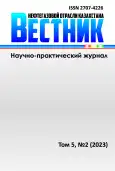The Effectiveness of the Introduction of the Water-Alternated-Gas Injection on the example of a Carbonate Field in Kazakhstan
- Authors: Askarova I.A.1, Uteyev R.N.2, Mardanov A.S.2, Jaxylykov T.S.2, Junusbayeva A.U.2
-
Affiliations:
- Tengizchevroil
- Atyrau branch of KMG Engineering
- Issue: Vol 5, No 2 (2023)
- Pages: 42-53
- Section: Oil and gas field development and exploitation
- URL: https://journal-vniispk.ru/2707-4226/article/view/250543
- DOI: https://doi.org/10.54859/kjogi108623
- ID: 250543
Cite item
Full Text
Abstract
Background: Water-Alternated-Gas Injection (hereinafter referred to as WAG) is considered to be a suitable analogue of gas injection and waterflooding, which increase the efficiency of displacement. With continuous gas injection, the displacement front is unstable due to the low viscosity of the gas, which leads to the formation of gas “tongues” due to a significant difference in the mobility of gas and oil. Alternate injection of water and gas is considered a suitable option in eliminating this problem and in stabilizing the displacement front.
Aim: The purpose of this work was to generalize the main factors affecting the efficiency of the process, based on the world experience in applying the WAG technology. The effectiveness of this technology application in a carbonate field was also considered.
Materials and methods: This article analyzes the efficiency of oil displacement using the WAG method in a carbonate field in Kazakhstan. In order to study the proposed oil production technology, the alternate injection of water and gas into the reservoir was simulated on the ECLIPSE 100 simulator. First of all, the process of optimizing the parameters was carried out based on two injection wells. As a result, it was found that for the studied field, the duration of water and gas cycles of 3 months and the sequence of "gas – water" are the optimal conditions for observing the greatest effect from WAG. Further, based on the selected parameters, WAG was scaled to the entire field, for the implementation of which several options were developed with 3, 5, 6 and 12 injection wells.
Results: As a result of the research, the optimal oil displacement option was selected, which involves 5 injection wells with high injectivity and a large volume of injected gas.
Conclusion: Due to the hydrophilicity of the reservoir, the effect of alternating WAG turned out to be not as significant as it could be expected, due to the effect of hysteresis of relative phase permeabilities, which can be a topic for future research.
Full Text
##article.viewOnOriginalSite##About the authors
Ingkar A. Askarova
Tengizchevroil
Author for correspondence.
Email: inkar.askarova11@gmail.com
Kazakhstan, Atyrau
Rakhim N. Uteyev
Atyrau branch of KMG Engineering
Email: r.uteyev@kmge.kz
Kazakhstan, Atyrau
Altynbek S. Mardanov
Atyrau branch of KMG Engineering
Email: a.mardanov@kmge.kz
Kazakhstan, Atyrau
Talgat S. Jaxylykov
Atyrau branch of KMG Engineering
Email: t.jaxylykov@kmge.kz
Kazakhstan, Atyrau
Ainura U. Junusbayeva
Atyrau branch of KMG Engineering
Email: a.junusbayeva@kmge.kz
Kazakhstan, Atyrau
References
- Kulkarni MM, Rao DN. Experimental investigation of miscible and immiscible Water-Alternating-Gas (WAG) process performance. Journal of Petroleum Science and Engineering. 2005;48(1–2):1-20. doi: 10.1016/j.petrol.2005.05.001.
- Telkov V, Lubimov N. Determining of oil and gas miscibility conditions in various conditions during gas and water-gas influence on layer. Driling and Oil. 2012;12:38–42.
- Christensen JR, Stenby EH, Skauge А. Review of WAG Field Experience. SPE Res Eval & Eng 4. 2001;97–106.
- Jackson DD, Andrews GL, Claridge EL. Optimum WAG Ratio vs. Rock Wettability in CO2 Flooding. SPE Annual Technical Conference and Exhibition; 1985 Sept; Las Vegas, Nevada. Paper Number: SPE-14303-MS.
- Sanchez NL. Management of Water Alternating Gas (WAG) Injection Projects. Latin American and Caribbean Petroleum Engineering Conference; 1999 Apr 21–23; Caracas, Venezuela. Paper Number: SPE- 53714 -MS.
- Afzali S, Rezaei N, Zendehboudi S. A comprehensive review on Enhanced Oil Recovery by Water Alternating Gas (WAG) injection. Fuel. 2018;227:218–246. doi: 10.1016/j.fuel.2018.04.015.
- Samba M, Elsharafi M. Literature Review of Water Alternation Gas Injection. Journal of Earth Energy and Engineering. 2018;6(1):33–45. doi: 10.25299/jeee.2018.vol7(2).2117.
- Belazreg L, Mahmood SM, Aulia A. Novel approach for predicting water alternating gas injection recovery factor. J Petrol Explor Prod Technol. 2019;9:2893–2910. doi: 10.1007/s13202-019-0673-2.
- Spiteri E, Juanes R. Impact of relative permeability hysteresis on the numerical simulation of WAG injection. Journal of Petroleum Science and Engineering. 2006;50(2):115–139. doi: 10.1016/j.petrol.2005.09.004.
- Kazakov KV, Bravichev KA, Lesnoy AN. Search of optimal conditions for placement of injection wells for gas injection and WAG. Exposition. Oil&Gas. 2016;1(47):37–41.
- Maklavani AM, Vatani A, Moradi B, Tangsirifard J. New minimum miscibility pressure (MMP) correlation for hydrocarbon miscible injections. Braz J Petrol Gas. 2010;4:011–018.
Supplementary files












